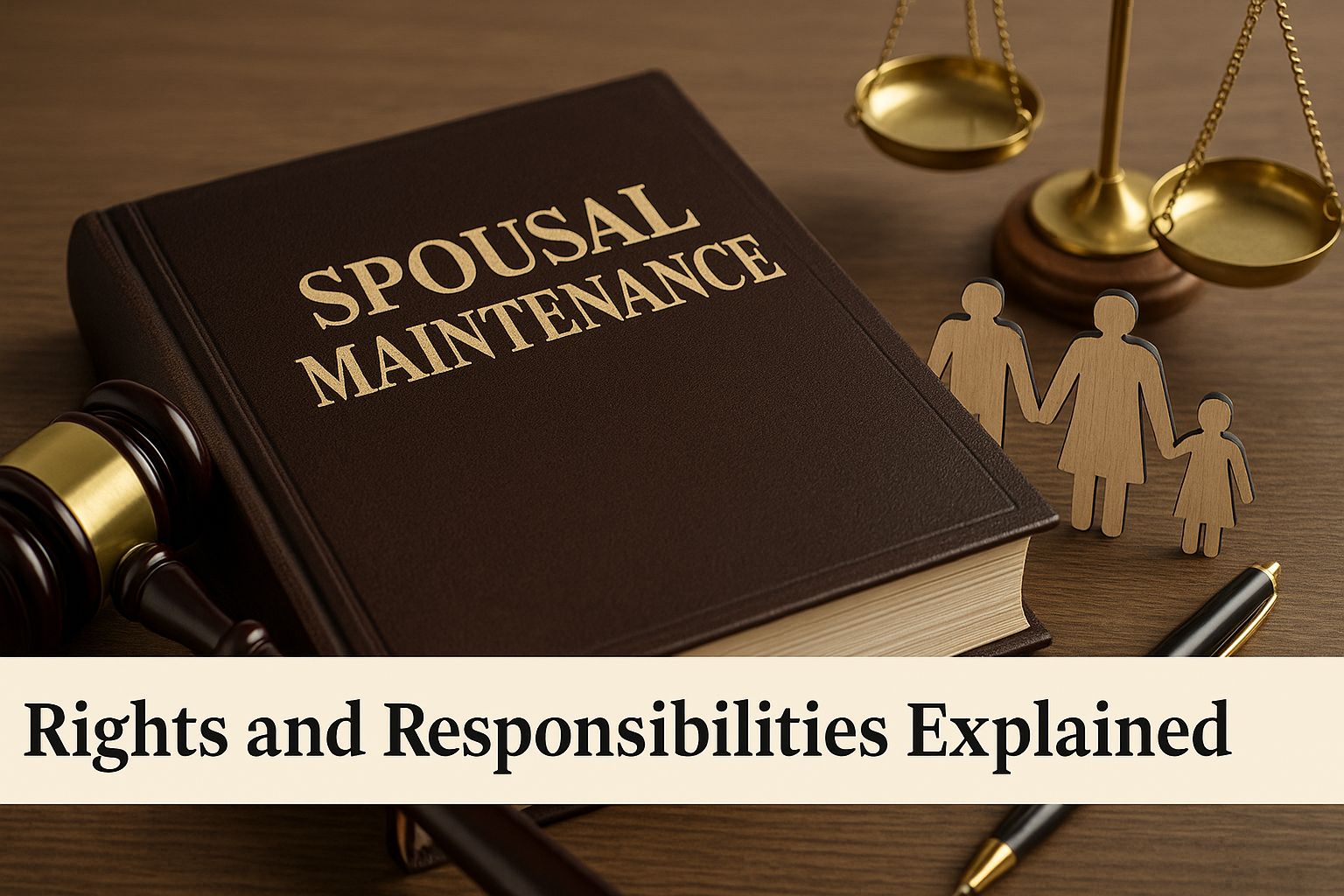Spousal Maintenance: Rights and Responsibilities Explained

What is Spousal Maintenance?
Spousal maintenance is a legal obligation for one partner to provide financial support to their former spouse or de facto partner. This obligation arises when one partner cannot adequately support themselves financially following the end of a relationship.
Legal Definition and Origins
In Australia, spousal maintenance is defined under the Family Law Act 1975. This legislation outlines the responsibilities and rights of parties post-separation. The law recognizes that, upon separation, financial disparity can arise, necessitating one party to support the other to achieve fairness.
Differences Between Spousal Maintenance and Child Support
While both spousal maintenance and child support involve financial support, they serve different purposes. Spousal maintenance is aimed at supporting a former partner who cannot meet their own reasonable expenses. In contrast, child support is strictly for the welfare of the children from the relationship.
Alimony vs. Spousal Maintenance
Often, the terms "alimony" and "spousal maintenance" are used interchangeably. However, "alimony" is more commonly used in countries like the United States, while "spousal maintenance" is the term preferred in Australia. Despite the terminology differences, the essence remains the same: financial support after a relationship ends.
Historical Context
The concept of spousal support has evolved over time. Historically, it was primarily aimed at women, reflecting societal norms where men were the primary earners. Modern spousal maintenance laws are gender-neutral and focus on financial disparity rather than gender roles.
Determining Spousal Maintenance in Australia
Several factors are considered when determining spousal maintenance in Australia, ensuring a fair assessment for both parties.
Factors Influencing Spousal Maintenance
Financial Needs: The court assesses the applicant's financial needs, including their living expenses and any other financial commitments. The aim is to ensure the applicant can maintain a reasonable standard of living.
Income and Earning Capacity: The earning capacity of both parties is evaluated. This includes considering the applicant's ability to gain employment or the reasons why they might be unable to work. Factors like education, experience, and current job market conditions are also considered.
Age and Health: The age and health of both parties play a role in determining maintenance. Older age or health issues might impede one's ability to work. Courts take into account any disabilities or chronic health conditions that affect employability.
Standard of Living: The standard of living enjoyed during the relationship is also considered, aiming to maintain a similar lifestyle post-separation. The court evaluates the lifestyle during the relationship to ensure fairness in the post-separation arrangement.
Children's Needs: If there are children involved, their needs can impact the spousal maintenance arrangements. The primary caregiver may require additional support to care for the children, affecting maintenance calculations.
Spousal Maintenance Calculator in Australia
For those seeking an estimate of potential spousal maintenance, various online calculators provide preliminary figures. These tools consider several variables, such as income, expenses, and duration of the relationship, to offer a rough idea of what to expect. For more information, visit resources like Family Court of Australia.
Legal Process and Court's Role
The court plays a crucial role in determining spousal maintenance. It assesses all relevant factors and decides based on fairness and equity. The decision-making process is guided by legal precedents and statutory guidelines.
Variability Across Cases
No two spousal maintenance cases are alike, as each situation is unique. Factors such as the length of the relationship, financial contributions of each partner, and future financial prospects are considered. This variability ensures that the outcome is tailored to the specific circumstances of each case.
Sample Display of Spousal Maintenance Form Submission Data
| Category | Applicant's Data | Payer's Data | System Analysis Result |
|---|---|---|---|
| Monthly Income | AUD 1,800 | AUD 5,200 | Payer has sufficient financial capacity to support |
| Monthly Living Expenses | AUD 2,300 | AUD 2,800 | Applicant shows genuine financial need |
| Health Condition | Chronic illness | Healthy | Applicant's ability to work is limited |
| Age | 52 | 49 | Applicant's age affects re-employment opportunities |
| Duration of Relationship | 15 years | 15 years | Long-term relationship supports maintenance request |
| Childcare Responsibilities | Yes, 2 minor children | No | Additional support may be required for childcare |
| Suggested Maintenance Amount | - | AUD 900/month | Recommended to maintain a fair standard of living |
| Suggested Payment Duration | - | 5 years or until stable job | Subject to periodic review and possible modification |
How to Apply for Spousal Maintenance
Applying for spousal maintenance involves several steps and requires careful preparation.
Steps to Apply
Legal Advice: Before proceeding, it's advisable to seek legal advice to understand your rights and obligations fully. A lawyer can provide guidance on the likelihood of success and help prepare your case.
Prepare Documentation: Gather all necessary financial documents, including income statements, expense records, and any other relevant financial information. Accurate documentation is crucial for a successful application.
File an Application: Submit the application to the Family Court or the Federal Circuit Court. Ensure that all documentation is accurate and complete. Incomplete or inaccurate applications can delay the process.
Court Proceedings: Attend court proceedings where both parties present their cases. The court will then decide on the maintenance amount and duration. It's essential to be prepared and present a compelling case to support your application.
The Importance of Legal Representation
Having a legal representative can significantly impact the outcome of your application. Lawyers understand the intricacies of family law and can advocate effectively on your behalf. They also provide emotional support during the often-stressful legal proceedings.
Common Challenges in the Application Process
Applicants often face challenges such as proving financial need or the other party's ability to pay. Documentation and evidence are critical in overcoming these challenges. Understanding potential obstacles and preparing adequately can improve your chances of a favorable outcome.
How Long Does Spousal Support Last?
The duration of spousal maintenance varies based on individual circumstances. It can be temporary, ending when the recipient becomes self-sufficient, or ongoing, depending on factors like age, health, and employment prospects.
Rights and Responsibilities
Understanding the rights and responsibilities of both parties involved in spousal maintenance is essential for compliance and fairness.
Rights of the Recipient
Right to Fair Assessment: The recipient has the right to a fair assessment of their financial needs and the payer's ability to contribute. Courts are obligated to ensure that the assessment process is transparent and just.
Right to Seek Modifications: If circumstances change, the recipient can request a review and modification of the maintenance amount. Changes like loss of employment or health issues can warrant a reassessment.
Right to Legal Recourse: In case of non-payment, the recipient can seek legal intervention to enforce the maintenance order. Legal channels ensure that the recipient receives the support they are entitled to.
Responsibilities of the Payer
Timely Payments: The payer is responsible for making timely and full payments as ordered by the court. Delays or missed payments can lead to legal consequences.
Disclosure of Financial Changes: Any significant changes in financial status should be disclosed, as they may impact the maintenance arrangement. Transparency is crucial to maintaining trust and fairness.
Adherence to Court Orders: The payer must adhere strictly to the court's maintenance order, with any modifications requiring court approval. Non-compliance can result in legal penalties, including fines or imprisonment.
Balancing Rights and Responsibilities
Both parties must balance their rights and responsibilities to ensure the maintenance arrangement works effectively. Open communication and cooperation can lead to more amicable resolutions. Understanding legal obligations helps prevent disputes and fosters mutual respect.

Frequently Asked Questions
Yes, while the term "alimony" is less commonly used, the concept of spousal maintenance serves the same purpose in Australia. It provides financial support to a former partner who needs assistance post-separation.
Determining spousal maintenance involves assessing the financial needs of the applicant and the payer's capacity to meet those needs, considering factors such as income, expenses, and standard of living. The process is guided by legal principles and aims to achieve fairness.
If a payer believes they should not be responsible for maintenance, they can present their case to the court, demonstrating an inability to pay due to financial hardship or changes in circumstances. Providing substantial evidence and a well-prepared case is crucial for success.
Mediation can play a vital role in resolving spousal maintenance disputes outside of court. It offers a less adversarial approach and can lead to mutually agreeable solutions. Mediators assist both parties in negotiating terms that reflect their needs and capabilities. Learn more about mediation at Family Relationships Online.
Spousal maintenance plays a vital role in ensuring financial fairness after the end of a relationship. Understanding your rights and responsibilities is crucial, whether you are the one receiving or paying maintenance. Seeking legal advice and staying informed about your obligations will help navigate the complexities of spousal maintenance effectively.
While the process can seem daunting, knowing the steps and factors involved can empower both parties to achieve a fair and equitable resolution. In a changing world, the importance of spousal maintenance in Australia remains significant, providing a safety net for those in need and ensuring that financial responsibilities are shared justly after separation.
The Future of Spousal Maintenance
As societal norms evolve, the laws surrounding spousal maintenance may continue to change. Staying informed about legal updates and societal trends is essential for all parties involved. The goal remains to ensure equity and support in the aftermath of relationship breakdowns.
AHL Legal: Your Family Law Partner
Navigating spousal maintenance or family law disputes? AHL Legal specializes in Australian family law, offering expert guidance on spousal maintenance, financial agreements, and post-separation support.
Navigate Spousal Maintenance with Confidence
Spousal maintenance can be complex, but with the right knowledge and legal support, both payers and recipients can achieve fair outcomes.
Whether you’re seeking maintenance or managing payment obligations, AHL Legal provides expert advice to protect your rights and ensure compliance.
✅ AHL Legal: Your Trusted Family Law Partner
At AHL Legal, we’re dedicated to supporting you through spousal maintenance, family law disputes, and legal proceedings. Our team specializes in family law, ensuring your interests are safeguarded.
📞 Ready to take action? Call 1300 91 66 77 for a consultation
🌐 Visit our website: www.ahllegal.com



 1300 91 66 77
1300 91 66 77







 HOME
HOME


